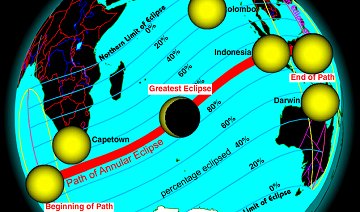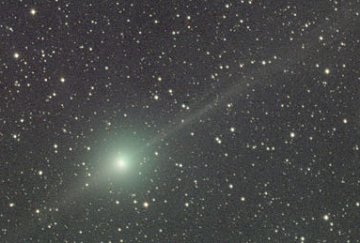| STRANGE ASTEROID: Newly-discovered asteroid 2009 BD is slowly passing by Earth today only 400,000 miles away. The small 10m-wide space rock poses no threat, but it merits attention anyway. The orbit of 2009 BD appears to be almost identical to the orbit of Earth. 2009 BD may be a rare co-orbital asteroid, circling the sun in near-tandem with our planet. Extrapolating the motion of 2009 BD into the future, we see that it remains in the vicinity of Earth for many months to come, never receding farther than 0.1 AU (9.3 million miles) until Nov. 2010. Future observations may reveal the nature of this strange asteroid; stay tuned! [3D orbit] [ephemeris] SOLAR ECLIPSE: The Year of the Ox is beginning with a solar eclipse. On Monday, Jan. 26th, the same new Moon that triggers the Chinese Lunar New Year will pass directly in front of the sun--dead center--covering 93% of the solar disk. The ensemble will form a stunning "ring of fire" visible across the Indian Ocean: 
Click on the image, above, to launch an animated map of the eclipse prepared by graphic artist Larry Koehn. A regional map of Indonesia shows the best dry places to see the ring of fire: Borneo, Sumatra and Java. Outside the narrow path of annularity, the Moon will cross the sun off-center, producing crescent suns of varying depth over south Africa, Madagascar, Australia, southern parts of India and southeast Asia. Sky watchers in those places should attend to the ground: crescent sunbeams will dapple the earth beneath leafy trees and garden latticework. Solar telescopes trained on the sky will show the Moon taking a bite out of the sun. Stay tuned for photos! Live Solar Eclipse Webcasts
[NASA eclipse home page] [time tables] APPROACHING COMET: Comet Lulin (C/2007 N3) is approaching Earth for a 38 million mile close encounter in late February. At that time, the comet could brighten to naked eye visibility (5th magnitude). Meanwhile, it's a nice target for backyard telescopes:  Chris Brennan of Barbados took the picture using a 7-inch telescope on Jan. 24th. "Note the double tail," he says. M. Mc Kenna sends this report from Northern ireland: "I checked out Comet Lulin this morning before dawn using a 8.5-inch reflector. My immediate impression was that the comet is very bright; the coma is healthy and active with an obvious green color. [Note: The 'coma' is the comet's gaseous atmosphere.] Seeing both tails at the same time was quite a treat! I also looked at the comet using a pair of binoculars and despite the poor quality of the opticsI was still able to find the comet easily. Finally, I tried very carefully to detect it with the naked eye but I just couldn't convince myself that it was visible. However, I suspect that with excellent sky conditions the first naked eye observations will be reported very soon. This comet could very well put on a good show in February!" Comet Lulin Photo Gallery
[Comet Hunter telescope] [sky map] [ephemeris]
Explore the Sunspot Cycle
Recent Fireballs: Jan. 23, Jan. 17, Dec. 29 | 
